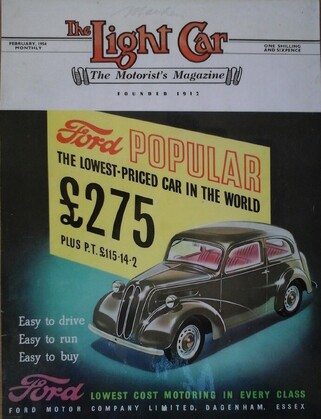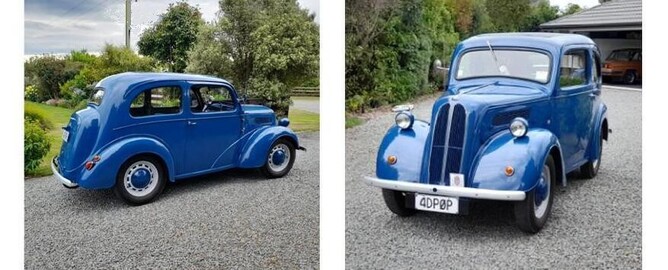There's quite a story with New Zealand's relationship with the Ford Popular. The tale begins in Britain...
When Ford introduced the shape to replace the Model Y back in 1937 it was designated the Model 7Y Eight. The new car was known as the Ford Eight - but little did anyone anticipate that this, the smallest car on offer by Ford of Britain, would have a model life of 22 years!
22 years! That's even longer than the incredibly long 19-year lifespan of the Model T Ford that damned near cost Mr Ford his company! But this time it was different. During that time the Ford Eight would be given two name changes (even the Model T didn't change its name during it's shorter production life). The Model 7Y Eight became the Ford Anglia in New Zealand in 1940. Following World War 2 the pre-war Anglia (and her big sister, the Ford Ten Prefect) underwent a subtle facelift and it continued to appear in the new car showrooms until 1953. That is when the all-new postwar Anglia and Prefect models were announced - both were designated the 100E.
But, as already hinted, alongside the flash new 100E cars on the show room floors was also displayed the familiar old Anglia - but now with another name-change. Why?
Why indeed. During the '50s, Britain had the lowest car-ownership ratio per person in the developed world. Whilst their public transport was, in contrast, second to none, the Brits still wanted the independence that a car of their own offered them. However, Britain remained virtually bankrupt while they paid for the cost of the war that had defeated Nazism. The populous could barely afford to put food on the table let alone have a car in the garage.
So Ford of Britain decided to do something about it. At little or no development cost, and to get the showroom price down, the now obsolete sit-up-and-beg Anglia was stripped of any superfluous parts (such as a passenger-side windscreen wiper) and chrome adornment (silver paint was used instead, such as on the bumpers and hub caps) and relaunched with a new name! This "new" product from Ford was aimed straight at that British market that so desperately wanted to buy a new motor car but simply could not afford one. Until now.
This was the Ford Popular!
According to the sticker Ford applied to the back window of every new Popular, this was "THE WORLD'S LOWEST PRICED CAR"!
But, here in New Zealand, we didn't need such a car! Therefore, Ford New Zealand decided not to import them. The reasons why become perfectly clear when one reads the Ford in New Zealand book.
Anyway, pushing book advertising aside, that is when the small Upper Hutt Ford agency called Howell's Motors saw an opportunity. Howell's Motors applied to the government for an import licence to bring in, from Mother England, semi-built up Ford Populars. And they got it! Now any Ford dealer throughout the motu who wanted one of these budget British cars could order one from their Upper Hutt colleague who, in turn, would place the order directly with Ford of Britain in Dagenham. Eventually a wooden crate containing the semi-built-up Pop would arrive at the dealership, complete with instructions on how to finish putting it together!
And that is how all of New Zealand's Ford Pops got here! That includes this incredible example owned by Howard Lester in Canterbury....
(DISCLAIMER! those orange indicator lights on Howard's car are NOT original fittings - indicators for the Popular were on Ford's list of superfluous parts, so not required!)
On page 152 of the book "Ford in New Zealand - Driving Ahead" there is a very revealing photo of a just-unpacked Ford Popular at a Ford dealership, showing the mechanic charged with assembling the car looking a little bewildered as he contemplates how to attach the front mudguard.
In my research for "Driving Ahead" the former Ford New Zealand sales and marketing director Reyn Penny told me "Howells sold hundreds of them!". Indeed the Ford Popular was a pretty common sight on New Zealand roads. Even government departments were buying them, including Social Welfare, Maori Affairs and the Public Trust. They were also popular as transport for those doing their rounds, such as District Nurses and Electricity Board meter readers.
Meanwhile, what of this upstart Ford agent in Upper Hutt? The suspicion is that Howells had most possibly made themselves less than popular within the executive suites at Ford New Zealand. Soon after, when Ford decided that the growing township of Upper Hutt warranted not just a piddly Ford agency but a full dealership, Howell's didn't get a look in! Tom Croft, who had worked for Ford in Seaview and then as sales manager at a new Ford dealership in Auckland, was appointed the new Upper Hutt dealer principal. And the old Ford agent was never heard from again!
Production of the Ford Popular stopped at Dagenham in 1959. It had played a really important role in the British car market, bringing motoring to the British masses albeit a little later than everywhere else in the developed world, and with a model that not only looked antiquated but indeed was antiquated. The demise of the Ford Popular was the last nail in the coffin for Ford's long-lived transverse axle suspension, which had its origins back more than half a century to 1908 and the Model T Ford!
For more on the Ford Popular in New Zealand, click here.



